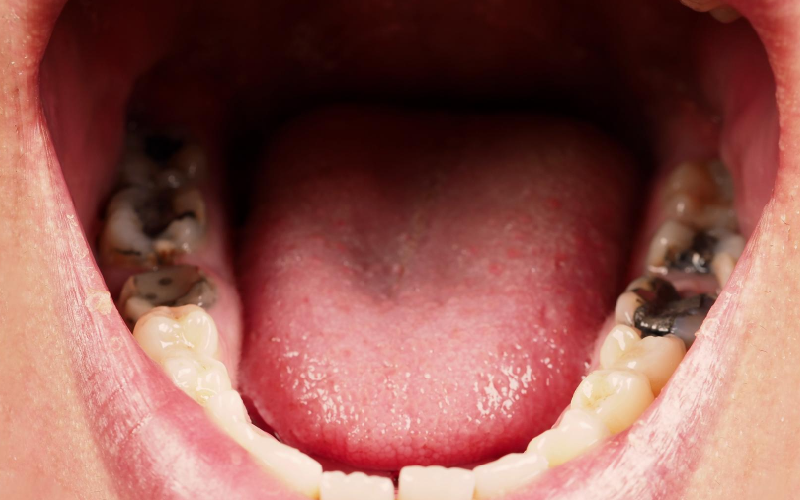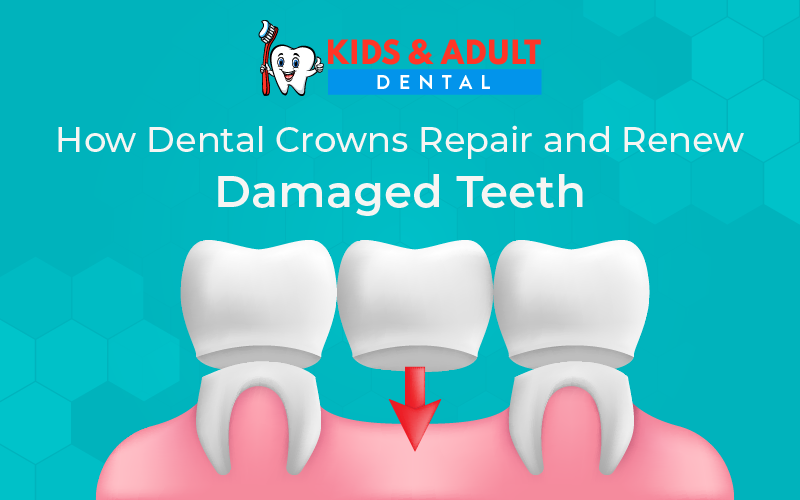When it comes to restoring damaged teeth and regaining a confident smile, dental crowns stand as a remarkable solution. From addressing cavities to revitalizing worn-down teeth, these versatile dental restorations play a pivotal role in modern dentistry.
Let’s delve into the world of dental crowns, exploring their types, benefits, and placement process.
Types of Dental Damage
Dental damage can manifest in various forms, each requiring a tailored solution for effective restoration. The most typical damage types are as follows:
1. Cavities and Decay

The relentless assault of bacteria on tooth enamel leads to cavities and decay, compromising both aesthetics and functionality. Dental crowns provide a durable shield against further deterioration, preserving the tooth’s structural integrity.
2. Cracks and Fractures
Trauma or biting forces can lead to cracks and fractures in teeth. Such damage not only jeopardizes oral health but can also cause discomfort. Dental crowns envelop and strengthen the compromised tooth, preventing further harm and restoring strength.
3. Worn Down or Weakened Teeth

Over time, teeth can become worn down due to grinding or erosion. Weakened teeth are susceptible to fractures and sensitivity. Dental crowns offer a robust reinforcement, effectively lengthening the lifespan of these teeth.
What Are Dental Crowns
Dental crowns, often referred to as caps, are prosthetic restorations meticulously crafted to resemble the natural anatomy of a tooth. They cover the visible portion of the tooth above the gumline, providing protection, strength, and a renewed appearance.
Reasons for Choosing a Dental Crown
-
Restoration of Functionality:
A damaged tooth can feel like a silent impediment, affecting the simplest of daily tasks. Dental crowns emerge as the architects of functionality, resurrecting your ability to bite, chew, and speak with confidence.
-
Aesthetic Enhancement:
Your smile is an integral part of your identity, and dental crowns are the artists who restore its brilliance. Discoloration, misalignment, or irregular shapes vanish under their expert touch, leaving behind a symphony of aesthetic perfection.
-
Preserving Weak Teeth:
Worn-down or weakened teeth may seem like they’ve lost their battle, but dental crowns are the reinforcements that turn the tide. They wrap around your teeth, transforming vulnerability into strength and ensuring a longer lease of life.
-
Protection After Procedures:
Procedures like root canals or extensive dental fillings often leave teeth vulnerable. Dental crowns act as sentinels, shielding these treated teeth from potential harm and preserving their newfound health.
Read Also: Tooth Discoloration: Top Foods and Drinks That Stain Your Teeth
Benefits of Dental Crowns
The advantages of choosing dental crowns extend beyond just physical appearance. These benefits encompass:
A. Durability: Dental crowns are crafted from robust materials, ensuring long-lasting protection.
B. Customization: Crowns are customized to match the color, shape, and size of your natural teeth.
C. Comfort: Properly fitted crowns seamlessly integrate into your bite and mouth, offering comfort.
D. Improved Oral Health: Crowns shield damaged teeth, preventing bacteria from infiltrating and causing infections.
E. Confidence Boost: The restoration of a damaged tooth to its former glory can significantly boost self-esteem.
Different Types of Dental Crowns
Dental crowns come in various materials, each with its unique properties:
-
Porcelain Crowns:

With a natural translucence that mirrors real teeth, porcelain crowns are often chosen for front teeth, where aesthetics reign supreme.
-
Metal Crowns:

When strength and durability are paramount, metal crowns—crafted from alloys like gold or silver—stand strong, predominantly adorning molars.
-
Porcelain-Fused-to-Metal Crowns:

This hybrid variety marries the sturdiness of metal with the aesthetic finesse of porcelain, making them versatile choices that blend seamlessly into both front and back teeth.
Read Also: The Benefits of Professional Teeth Whitening
The Dental Crown Placement Process
1: Assessment and Preparation:
The journey towards a dental crown begins with a comprehensive assessment by your dentist. During this initial stage, your dentist examines the affected tooth to determine its overall health and the extent of damage.
If a dental crown is deemed necessary, the next step is tooth preparation. To make room for the crown, the tooth must be carefully reshaped in this manner.
In cases where the tooth has significant damage or decay, your dentist might also use a filling material to restore its structural integrity.
2: Temporary Crown:
Once the tooth is prepared, a temporary crown is fitted onto it. This temporary crown serves as a protective covering for the reshaped tooth while the permanent crown is being crafted.
While temporary crowns are not as durable as permanent ones, they play a crucial role in maintaining your ability to eat and speak comfortably during the interim period.
It’s important to be gentle with temporary crowns, as they are designed for short-term use.
3: Crown Fabrication:

The impression taken during the initial assessment is a critical component in crafting the final crown. This impression is sent to a dental laboratory where skilled technicians use it as a guide to create your permanent crown.
Depending on the materials chosen for the crown (such as porcelain, ceramic, or metal alloys), the fabrication process might take a few weeks to ensure the crown is meticulously crafted to match your unique dental structure.
4: Final Fitting and Cementing:
Once the permanent crown is ready, you return to the dentist’s office. The temporary crown is carefully removed, and the permanent crown is tried on the reshaped tooth. Your dentist evaluates its fit, color, and shape to ensure it seamlessly blends with your natural teeth.
If any adjustments are needed, they are made at this stage to achieve the perfect fit. Once satisfied, the permanent crown is permanently cemented onto the prepared tooth using dental adhesive.
5: Polishing and Aftercare:

With the crown securely in place, your dentist proceeds to polish its surface, ensuring it feels smooth and natural within your mouth.
Additionally, your bite is checked to ensure that it aligns correctly with your other teeth, preventing any unnecessary strain. Before leaving the office, you’ll receive aftercare instructions.
These guidelines will help you maintain the crown’s longevity by practicing good oral hygiene, such as regular brushing, flossing, and attending routine dental check-ups.
Temporary vs. Permanent Crowns
-
Temporary Crowns:
Temporary crowns are short-term placeholders that shield prepared teeth while awaiting permanent crowns. They’re made from less durable materials, maintaining appearance and function during the interim period.
-
Permanent Crowns:
Permanent crowns are the ultimate solution. Custom-made from robust materials, they restore full functionality and appearance, blending seamlessly with natural teeth for a lasting and confident smile.
When to Consider Crown Replacement?
As time paints its mark, even dental crowns may warrant renewal. Factors like wear, discoloration, or changes in dental health might indicate the need for replacement. Regular dental assessments unveil when it’s time to refresh your crown’s brilliance.
The Bottom Line
As we conclude this exploration of dental crowns, it’s evident that these remarkable creations intertwine science and artistry to restore both dental function and aesthetics. From shielding against decay to reigniting self-assurance through a revitalized smile, dental crowns hold the key to renewed oral health and confidence.
For those seeking exceptional Affordable dental services in Denver, CO, our dedicated Kids & Adult Dental Clinic is your destination. Our skilled team combines expertise with compassion to provide comprehensive dental care for patients of all ages.
Whether it’s catering to the unique needs of children or offering advanced solutions for adults, our commitment to excellence remains unwavering.


